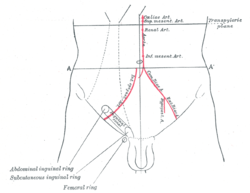Inguinal canal
| Inguinal canal | |
|---|---|
 Front of abdomen, showing surface markings for arteries and inguinal canal. (Inguinal canal is tube at lower left.) | |
 The scrotum. On the left side the cavity of the tunica vaginalis has been opened; on the right side only the layers superficial to the Cremaster have been removed. (Right inguinal canal visible at upper left.) | |
| Details | |
| Identifiers | |
| Latin | canalis inguinalis |
| MeSH | A01.047.412 |
| TA | A04.5.01.026 |
| FMA | 19928 |
The inguinal canal is a passage in the anterior abdominal wall that in men conveys the spermatic cord and in women the round ligament of uterus. The inguinal canal is larger and more prominent in men. There is one inguinal canal on each side of the midline.
Structure
The inguinal canal is situated just above the medial half of the inguinal ligament. In both sexes the canal transmits the ilioinguinal nerve. The canal is approximately 3.75 to 4 cm long. , angled anteroinferiorly and medially.
A first-order approximation is to visualize the canal as a cylinder.[1]
Walls
To help define the boundaries, the canal is often further approximated as a box with six sides. Not including the two rings, the remaining four sides are usually called the "anterior wall", "posterior wall", "roof", and "floor".[2] These consist of the following:
| superior wall (roof): Medial crus of aponeurosis of external oblique Musculoaponeurotic arches of internal oblique and transverse abdominal Transversalis fascia | ||
| anterior wall: aponeurosis of external oblique fleshy part of internal oblique (lateral third of canal only)[3] superficial inguinal ring (medial third of canal only)[4] | (inguinal canal) | posterior wall: transversalis fascia conjoint tendon (Inguinal falx,reflected part of inguinal ligament, medial third of canal only)[4] deep inguinal ring (lateral third of canal only)[4] |
| inferior wall (floor): inguinal ligament lacunar ligament (medial third of canal only)[4] iliopubic tract (lateral third of canal only)[3] |
Development
During development gonads (ovaries or testes) descend from their starting point on the posterior abdominal wall (para-aortically) from labioscrotal swelling near the kidneys down the abdomen and through the inguinal canal to reach the scrotum. The testis then descends through the abdominal wall into the scrotum, behind the processus vaginalis (which later obliterates). Thus lymphatic spread from a testicular tumour is to the para-aortic nodes first, and not the inguinal nodes.
Function
The structures which pass through the canal differ between males and females:
- in males: the spermatic cord[5] and its coverings + the ilioinguinal nerve.
- in females: the round ligament of the uterus + the ilioinguinal nerve.
The classic description of the contents of spermatic cord in the male are:
3 arteries: artery to vas deferens (or ductus deferens), testicular artery, cremasteric artery;
3 fascial layers: external spermatic, cremasteric, and internal spermatic fascia;
3 other structures: pampiniform plexus, vas deferens (ductus deferens), testicular lymphatics;
3 nerves: genital branch of the genitofemoral nerve (L1/2), sympathetic and visceral afferent fibres, ilioinguinal nerve (N.B. outside spermatic cord but travels next to it)
Note that the ilioinguinal nerve passes through the superficial ring to descend into the scrotum, but does not formally run through the canal.
Clinical significance
Abdominal contents (potentially including intestine) can be abnormally displaced from the abdominal cavity. Where these contents exit through the inguinal canal the condition is known as an indirect or oblique inguinal hernia. This can also cause infertility. This condition is far more common in men than in women, owing to the inguinal canal's small size in women.
A hernia that exits the abdominal cavity directly through the deep layers of the abdominal wall, thereby bypassing the inguinal canal, is known as a direct inguinal hernia.
Additional images
| Wikimedia Commons has media related to Inguinal canal. |
-

The spermatic cord in the inguinal canal.
-
Inguinal fossae
See also
References
- ↑ "Gross Anatomy Image". Retrieved 2007-11-20.
- ↑ Adam Mitchell; Drake, Richard; Gray, Henry David; Wayne Vogl (2005). Gray's anatomy for students. Elsevier/Churchill Livingstone. p. 260. ISBN 0-443-06612-4.
- 1 2 Dalley, Arthur F.; Moore, Keith L. (2006). Clinically oriented anatomy. Hagerstown, MD: Lippincott Williams & Wilkins. p. 217. ISBN 0-7817-3639-0.
- 1 2 3 4 Arthur F., II Dalley; Anne M. R. Agur. Grant's Atlas of Anatomy. Hagerstown, MD: Lippincott Williams & Wilkins. p. 102. ISBN 0-7817-4255-2.
- ↑ "Anatomy Tables - Inguinal Region". Retrieved 2007-11-20.
^ Adam Mitchell; Drake, Richard; Gray, Henry David; Wayne Vogl (2010). Gray's anatomy for students. Elsevier/Churchill Livingstone. pp. 286. ISBN 0-443-06612-4.
External links
- Anatomy photo:36:01-0102 at the SUNY Downstate Medical Center
- Atlas image: abdo_wall63 at the University of Michigan Health System - "The Male & Female Inguinal Canal"
- Diagram at nurseminerva.co.uk
| ||||||||||||||||||||||||||||||||||||||||